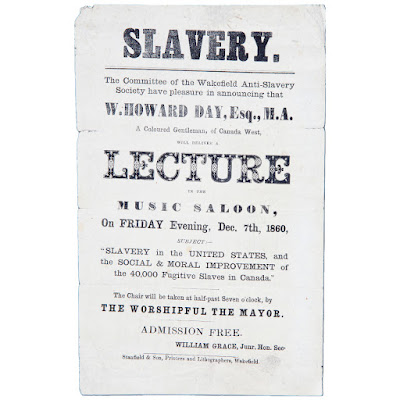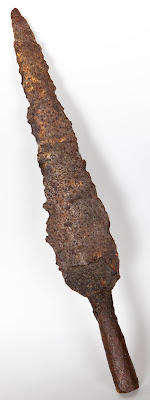We've loved seeing how much you have enjoyed our 100 Years of Collecting digital content over the past year!
As we bring our centenary celebrations to a close, we asked our Facebook followers to vote on their favourite of the 100 objects in the online exhibition.
Here's a spotlight on the objects you chose to round things up! The 100 Years of Collecting online exhibition will continue to stay live here on our blog.
Please note: one of the objects described in this article refers to the transatlantic slave trade, which uses an outdated historical term.
Madam Connie's wig
 |
| Madam Connie's wig as it was on display in the Moving Stories exhibition |
Made in: the 2010s
Collected in: 2019
Associated place: Wakefield
Steven Ogilvie wore this wig as his fabulous drag queen persona, Madam Connie, at performances in Wakefield.
Steven donated the wig to the museum in 2019 along with other outfits after Madam Connie hung her up stilettos for the last time. Steven also recorded an oral history about his experiences performing as Connie. He says performing increased his confidence and helped him through difficult times.
We loved including the wig in our recent Moving Stories exhibition! It's now taking a well-earned rest back at our Museum Store.
It was Madam Connie's friends and followers that got her wig well and truly voted onto this favourites list!
Sandal Castle ring
 |
| The Sandal Castle ring, which is on display at Wakefield Museum |
Made in: between 1485 and 1600
Collected in: 1983
Associated place: Sandal / Sandal Castle
This beautiful gold ring was found by archaeologists at Sandal Castle during excavations in the 1960s. It is about 500 years old.
It is called a 'love ring' because it has a lovers’ promise on it.
The wording on this one says ‘tout le vos’tre’, which means ‘I am all yours’ in medieval French (the language of the upper classes in the Middle Ages).
It's one of our star objects in the permanent Wakefield Stories display at Wakefield Museum.
It's perhaps unsurprising that such a beautiful and heartfelt object scored so highly with our Facebook followers!
Britain's oldest post box
 |
| Britain's oldest postbox - on display at Wakefield Museum |
Made in: 1809
Collected in: 1964
Associated place: Wakefield
Wakefield Museum has some quietly important objects such as this post box, the oldest in Britain!
It was installed in Wakefield Post Office on Wood Street in 1809 and predates the Victorian Penny Post by 30 years.
Our objects and sites aren't just special because of their history. One Facebook user voted for the post box because "it reminds me of one of my delightful friends I made through the museum"!
Another said "I'm voting for the post box because they used to be every day street furniture but now... they are little windows into our history."
Ballot Box
 |
| One of the ballot boxes used in Britain's first ever secret ballot in 1872 - on display at Pontefract Museum |
Made in: 1870sCollected in: 1978
Associated place: Pontefract
From one groundbreaking box - to another!
On the 15 August 1872, the first ever secret ballot in Britain to elect an MP was held in Pontefract.
This was the first time that people had voted in secret by placing an ‘X’ on a ballot paper next to the name of their choice.
Before this, people voted openly and could be easily pressured and bullied.
The ballot box was sealed with a liquorice stamp made from Frank Dunhill's factory to ensure it wasn't tampered with. There are still remnants of this seal on our box, which you can see on display at Pontefract Museum.
At this time, only men over the age of 21 who owned property could vote. Women couldn't vote until 1928, and the voting age was lowered to 18 only in 1969.
It's a piece of national political history of which Pomfretians are rightly very proud!
Nymph Stone
 |
| The 'nymph stone' on display at Castleford Museum |
Made in: Roman eraCollected in: 1990s
Associated place: Castleford
This carving of two female heads is dedicated ‘to the Nymphs’, nature spirits usually linked to springs and running water.
Dedications to nymphs are often found near military sites like the Roman fort at Castleford.
The fort at Castleford was known as 'Lagentium' to the Romans.
One Facebooker said they chose it because "this kind of artefact always benefits from re- examination and interpretation as time passes and knowledge expands".
What a brilliant sentiment about this special object! It's on display at Castleford Museum with lots of other ancient objects worthy of a closer look.
Anti-slavery lecture poster
 |
| A poster promoting W. Howard Day's anti-slavery lecture in 1860, on display at Wakefield Museum |
Made in: 1860
Collected in: 1923
Associated place: Wakefield
This poster advertises a lecture given by William Howard Day from 'Canada West' in the Music Saloon on Wood Street in Wakefield in December 1860.
The lecture took place at an important moment in the story of slavery, just a few months before the start of the American Civil War, a conflict based on the continued ownership and abuse of enslaved people by the plantation owners of the Southern States of America.
Several celebrated abolitionists such as Day visited this country and resonated with the working people in the North of England.
Many towns like Wakefield had an active abolitionist campaign movement and invited speakers to venues such as the Music Saloon on Wood Street and the Corn Exchange on Westgate.
One Facebook user said they were voting for this because it is "an important part of the empathetic community spirit of the Wakefield district". Lovely words indeed.
It's also one of the earliest objects added to our collection, as it was collected in 1923!
Battle of Wakefield iron spearhead
 |
| An iron spearhead dating to The Battle of Wakefield in 1460 - on display at Wakefield Museum |
Made in: 15th CenturyCollected in: 1959
Associated place: Sandal / Sandal Castle
This iron spearhead dates to the time of the Battle of Wakefield in 1460. The Battle was a major clash in the Wars of the Roses.
Richard, Duke of York, leader of the Yorkist faction and his eldest son, Edmund, Earl of Rutland, were both killed along with hundreds or even thousands of their supporters.
It is this event that likely lead to the rhyme 'Richard Of York Gave Battle In Vain', to remember the order of colours in a rainbow.
This spear head was found in the Portobello estate, the site of the battle, and was probably used by an infantryman at the battle.
Pontefract Castle Keirincx painting
 |
| Pontefract Castle painted by Alexander Keirincx in the 1640s - on display at Pontefract Museum |
Made in: 1640sCollected in: 1965
Associated place: Pontefract
It was painted by the Flemish landscape painter Alexander Keirincx, at the request of Charles I. It shows what a grand site it was, and much larger than the standing remains today might suggest.
Shared with thanks to The Hepworth Wakefield.
Post a comment with what you think we should include in the next 100 objects we collect!









No comments:
Post a Comment
We would love your comments - though they may take a day or two to appear.